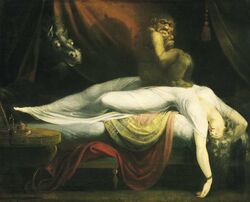Sleep paralysis

Sleep paralysis is a naturally occurring transition state of the body, in which, either when falling asleep or awakening, the skeletal musculature is temporarily paralyzed. This happens in order to prevent the sleeper's body from moving during dreams. This process can be accompanied by hallucinations. Usually, the paralysis disappears once the dreamer is awakening.
It can occur at sleep onset (Hynagogia) or upon awakening (Hypnopompia), and it is often associated with terrifying visions and external hallucinations (e.g., an intruder in the room or a demon sitting on one's chest) to which one is unable to react due to paralysis. It is believed to be a result of disrupted REM sleep, which is normally characterized by a complete loss of muscle control that prevents individuals from acting out their dreams.
Many people find sleep paralysis to be a horrific and negative experience due to the hallucinations to which they cannot react, but it can usually be escaped by simply changing the rhythm of one's breathing. When one changes their breathing pattern, such as holding one's breath or breathing much more deeply for roughly 15 seconds or more, the body will likely notice the change and exit sleep paralysis.
Effects
Triggers of sleep paralysis
Prevention
History and culture
This History and culture section is a stub. As a result, it may contain incomplete or wrong information. You can help by expanding it. |
Experience reports
Anecdotal reports which describe this effect within our experience index include: